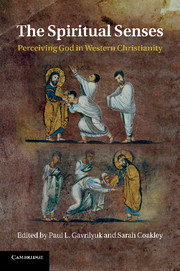Book contents
- Frontmatter
- Contents
- Contributors
- Foreword
- Abbreviations
- Introduction
- Chapter 1 Origen of Alexandria
- Chapter 2 Gregory of Nyssa
- Chapter 3 Augustine
- Chapter 4 Gregory the Great
- Chapter 5 Pseudo-Dionysius the Areopagite
- Chapter 6 Maximus the Confessor
- Chapter 7 Alexander of Hales
- Chapter 8 Thomas Gallus
- Chapter 9 Bonaventure
- Chapter 10 Thomas Aquinas
- Chapter 11 Late medieval mystics
- Chapter 12 Nicholas of Cusa
- Chapter 13 Jonathan Edwards and his Puritan predecessors
- Chapter 14 John Wesley
- Chapter 15 Karl Rahner and Hans Urs von Balthasar
- Chapter 16 Analytic philosophers of religion
- Select bibliography
- General index
- Index of select biblical references
- References
Chapter 11 - Late medieval mystics
Published online by Cambridge University Press: 05 December 2011
- Frontmatter
- Contents
- Contributors
- Foreword
- Abbreviations
- Introduction
- Chapter 1 Origen of Alexandria
- Chapter 2 Gregory of Nyssa
- Chapter 3 Augustine
- Chapter 4 Gregory the Great
- Chapter 5 Pseudo-Dionysius the Areopagite
- Chapter 6 Maximus the Confessor
- Chapter 7 Alexander of Hales
- Chapter 8 Thomas Gallus
- Chapter 9 Bonaventure
- Chapter 10 Thomas Aquinas
- Chapter 11 Late medieval mystics
- Chapter 12 Nicholas of Cusa
- Chapter 13 Jonathan Edwards and his Puritan predecessors
- Chapter 14 John Wesley
- Chapter 15 Karl Rahner and Hans Urs von Balthasar
- Chapter 16 Analytic philosophers of religion
- Select bibliography
- General index
- Index of select biblical references
- References
Summary
The mid-thirteenth-century German Franciscan David of Augsburg wrote one of the most popular handbooks of spiritual guidance of the late Middle Ages, whose title, The Composition of the Interior and Exterior Man according to the Triple State of Beginners, Proficient and Perfect, demonstrates its traditional approach. David expressed concern about the emphasis on visions and ecstatic experiences typical of many late medieval mystics, in part because these authors seemed to blur the distinction between interior experience and external sensation. At one point he singles out erotic visions of kissing and embracing that could even involve ‘being caressed by other less decent deeds and acts, so that just as the interior spirit is consoled by Christ or Mary, so too the exterior flesh is caressed in a physical way and carnally consoled by a sensation of delight fitted to it’. David is a witness to aspects of late medieval mysticism that seem to challenge the traditional distinction between external, bodily sensation and a separate set of interior, spiritual senses seen as organs of affective intentionality directed to God and the heavenly world.
The evolution of the category of spiritual sensation is long and varied, as the chapters of this volume demonstrate. To what extent did at least some late medieval mystics present teachings on perceiving God that tended to undermine, or negate, the distinction between inner and outer sensation, so that encountering the divine was presented as perceived in a corporeo-spiritual totality? Any adequate answer to this question would need a book, not a single chapter, to investigate the evidence. What follows is only a sounding in the capacious sea of late medieval mystical views on the role of sensation, inner and outer, in the path to God. To gain some sense of the teaching of some mystics in this domain, it is helpful to keep in mind a series of questions. First, what kind of language does the mystic use for describing how God is perceived? Second, does this language involve an explicit or implicit distinction between inner and outer sensation? If the distinction is explicit, does this mean that the spiritual senses are to be conceived of as a second set of senses, primarily as ways of describing interior cognition? Third, how does the mystic relate the various forms of sensation (inner and outer, or both together)? Is there, for example, a distinct form of knowing ascribed to each form of sensation? Is there a prioritizing of the senses? Finally (and this was increasingly important in the late Middle Ages), is there a discussion of how to discern the difference between true and false perceptions of God? To pursue each of these questions, even with regard to only a few mystics, would be a large task. My observations here will begin to sketch out something of this large terrain. Despite many helpful studies, we are still at the beginning of in-depth consideration of this central theme in the history of mysticism.
- Type
- Chapter
- Information
- The Spiritual SensesPerceiving God in Western Christianity, pp. 190 - 209Publisher: Cambridge University PressPrint publication year: 2011
References
- 2
- Cited by



